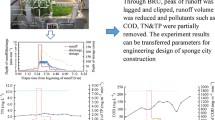Abstract
Hydrologic performance of bioretention systems is significantly influenced by the media composition and underdrain configuration. This research measured hydrologic performance of column-scale bioretention systems during a synthetic design storm of 25.9 mm, assuming a system area:catchment area ratio of 5%. The laboratory experiments involved two different engineered media and two different drainage configurations. Results show that the two engineered media with different sand aggregates were able to retain about 36% of the inflow volume with free drainage configuration. However, the medium with marine sand is better at delaying the occurrence of drainage than the one with pumice sand, denoting the better detention ability of the former. For both engineered media, an underdrain configuration with internal water storage (IWS) zone lowered drainage volume and peak drainage rate as well as delayed the occurrence of drainage and peak drainage rate, as compared to a free drainage configuration. The USEPA SWMM v5.1.11 model was applied for the free drainage configuration case, and there is a reasonable fit between observed and modeled drainage-rates when media-specific characteristics are available. For the IWS drainage configuration case, air entrapment was observed to occur in the engineered medium with marine sand. Filling of an IWS zone is most likely to be influenced by many factors, such as the structure of the bioretention system, medium physical and hydraulic properties, and inflow characteristics. More research is needed on the analysis and modeling of hydrologic process in bioretention with IWS drainage configuration.

Similar content being viewed by others
Explore related subjects
Discover the latest articles and news from researchers in related subjects, suggested using machine learning.References
Davis A P, Hunt WF, Traver R G, Clar M. Bioretention technology: overview of current practice and future needs. Journal of Environmental Engineering, 2009, 135(3): 109–117
Roy-Poirier A, Champagne P, Filion Y. Review of bioretention system research and design: past, present, and future. Journal of Environmental Engineering, 2010, 136(9): 878–889
Meng Y, Wang H, Chen J, Zhang S. Modelling hydrology of a single bioretention system with HYDRUS-1D. The Scientific World Journal, 2014, 2014(3–4): 521047
Jia H, Wang X, Ti C, Zhai Y, Field R, Tafuri A N, Cai H, Yu S L. Field monitoring of a LID-BMP treatment train system in China. Environmental Monitoring and Assessment, 2015, 187(6): 1–18
Jia H, Yao H, Yu S L. Advances in LID BMPs research and practice for urban runoff control in China. Frontiers of Environmental Science & Engineering, 2013, 7(5): 709–720
Brown R A, Hunt W F. Underdrain configuration to enhance bioretention exfiltration to reduce pollutant loads. Journal of Environmental Engineering, 2011, 137(11): 1082–1091
Sharkey L J. The performance of bioretention areas in North Carolina: a study of water quality, water quantity, and soil media. Thesis for Master Degree. Raleigh, NC: North Carolina State University, 2006
Winston R J, Dorsey J D, Hunt W F. Quantifying volume reduction and peak flow mitigation for three bioretention cells in clay soils in northeast Ohio. Science of the Total Environment, 2016, 553: 83–95
Li H, Sharkey L J, Hunt W F, Davis A P. Mitigation of impervious surface hydrology using bioretention in North Carolina and Maryland. Journal of Hydrologic Engineering, 2009, 14(4): 407–415
Rossman L A. Storm Water Management Model User’s Manual, Version 5.0. Cincinnati, United States: Water Supply and Water Resources Division, National Risk Management Research Laboratory, United States Environmental Protection Agency, 2010
Torbati S S. Pollutant removal evaluation and hydrologic characterization by continuous simulation for a concrete lined bioretention. Thesis for Master Degree. Auckland, New Zealand: University of Auckland, 2010
Liu R, Fassman-Beck E. Effect of composition on basic properties of engineered media for living roofs and bioretention. Journal of Hydrologic Engineering, 2016, 21(6): 06016002
Fassman-Beck E, Wang S, Simcock R, Liu R. Assessing the effects of bioretention’s engineered media composition and compaction on hydraulic conductivity and water holding capacity. Journal of Sustainable Water in the Built Environment, 2015, 1(4): 04015003
Liu R, Fassman-Beck E. Hydrologic response of engineered media in living roofs and bioretention to large rainfalls: experiments and modeling. Hydrological Processes, 2017, 31(3): 556–572
National Institute of Water and Atmospheric Research. High Intensity Rainfall System V3. Available online at http://hirds.niwa. co.nz (accessed May 29, 2013)
Dooge J C I. The rational method for estimating flood peaks. Engineering, 1957, 184(1): 311–313, 374–377
American Society for Testing and Materials. Standard Test Methods for Measurement of Hydraulic Conductivity of Unsaturated Soils: ASTM D7664–10. West Conchohocken, PA: ASTM International, 2010
Liu R. Infiltration models for engineered media in living roofs and bioretention. Dissertation for the Doctoral Degree. Auckland, New Zealand: University of Auckland, 2016
American Society for Testing and Materials. Standard Test Method for Permeability of Granular Soils (Constant Head): ASTM D2434–68. West Conchohocken, PA: ASTM International, 2006
Nash J E, Sutcliffe J V. River flow forecasting through conceptual models: Part I — A discussion of principles. Journal of Hydrology (Amsterdam), 1970, 10(3): 282–290
Jain S K, Sudheer K P. Fitting of hydrologic models: a close look at the Nash–Sutcliffe index. Journal of Hydrologic Engineering, 2008, 13(10): 981–986
Weeks E P. The Lisse effect revisited. Ground Water, 2002, 40(6): 652–656
Acknowledgements
The authors appreciate Dr. Robyn Simcock and John Dando at Landcare Research for help in data measurements and interpretation. The first author would also like to thank the China Scholarship Council for providing the doctoral scholarship ([2010]3006) for her PhD studies, and the University of Auckland for providing funding for experiments.
Author information
Authors and Affiliations
Corresponding author
Rights and permissions
About this article
Cite this article
Liu, R., Fassman-Beck, E. Hydrologic experiments and modeling of two laboratory bioretention systems under different boundary conditions. Front. Environ. Sci. Eng. 11, 10 (2017). https://doi.org/10.1007/s11783-017-0951-5
Received:
Revised:
Accepted:
Published:
DOI: https://doi.org/10.1007/s11783-017-0951-5




